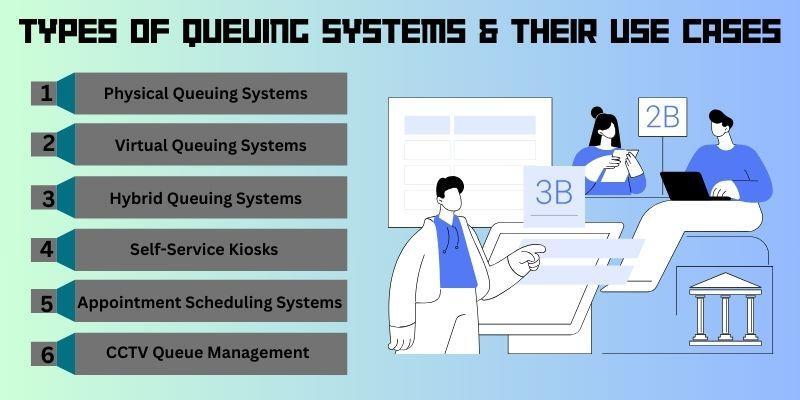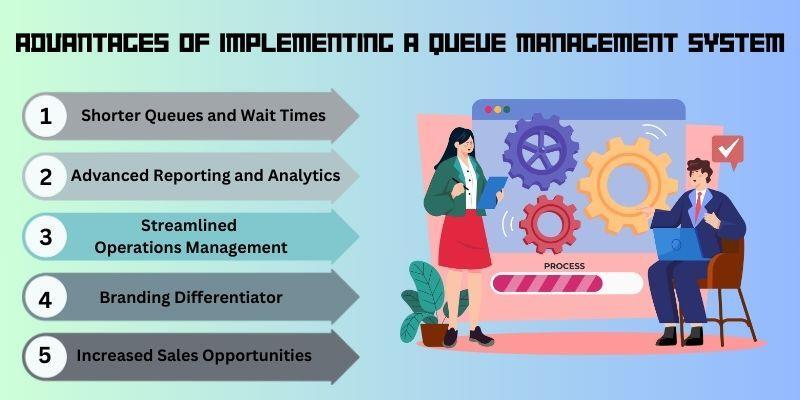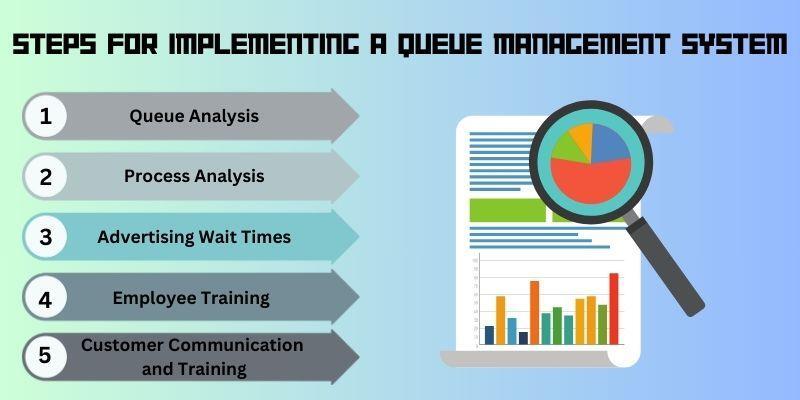Implementing a queue management system (QMS) is essential in today’s fast-paced, service-oriented world. It can be used by hospitals, banks, retail stores, or restaurants. Effectively managing waiting times can significantly improve customer satisfaction and loyalty.
Studies by Zendesk show that over 60% of customers consider long wait times the most frustrating part of the service experience, which can negatively impact brand perception.
Therefore, an efficient queue management system implementation reduces wait times, boosts customer satisfaction, increases operational efficiency, and builds a positive brand reputation.
A QMS has features like real-time queue monitoring and data analytics that provide valuable insights, helping businesses better manage customer flow and optimize staffing levels.
This article will examine the benefits, types, steps, and challenges associated with deploying a Queue Management System.
This information will serve as a comprehensive guide to help businesses make informed decisions about implementing a Queue Management Solution that meets their unique needs.
What is a Queue Management System?
A Queue Management System (QMS) is a technology-driven solution that efficiently manages and aligns customer flow. Its primary goal is to organize and monitor physical or virtual queues to reduce wait times and enrich the customer journey.
With advanced features, a queue management system deployment handles customer requests systematically by assigning each person a place in line and notifying them when it’s their turn for service.
Essential functions of a Queue Management System include tracking wait times, managing customer flow, collecting data, and generating actionable insights.
Implementing queue management systems is particularly beneficial in high-traffic industries like banking, healthcare, and retail, where managing customer expectations is crucial.
When leveraging a queue management solution integration, businesses can significantly improve their service delivery, leading to happier customers and more efficient staff operations.
Types of Queuing Systems and Their Use Cases

Businesses have several options when choosing a queue management system. Different types of queuing systems are suited to various industries and customer needs, as outlined below:
1. Physical Queuing Systems
Physical queuing systems represent the traditional method of queue management. They require customers to physically stand in line or take a number and wait to be called.
One example is the “take-a-number” approach, where customers receive a numbered ticket and are served in order. This form of queue management system implementation is particularly effective in settings where face-to-face service is necessary, such as retail counters or government offices.
Use Cases:
- Retail Stores: Managing checkout lines efficiently
- Service Counters: In banks or post offices where customers are served sequentially
- Event Venues: Queue management for entries and exits
Benefits: Physical queuing systems are simple and require minimal technical infrastructure, making them an easy-to-implement solution for businesses that rely on on-site service delivery.
2. Virtual Queuing Systems
Virtual queuing systems allow customers to join a queue remotely, usually via a mobile app or website. This setup is ideal for service sectors prioritizing flexibility, as it minimizes on-site congestion and improves convenience.
With a virtual queue management system deployment, customers can track their position in line, receive updates, and be notified when it’s their turn.
Use Cases:
- Healthcare: Patients can check in virtually and wait at home until their appointment
- Restaurants: Customers join the waitlist remotely, freeing them from physically waiting
- Salons and Spas: Clients book time slots and view wait times on their devices
Benefits: Virtual queuing increases customer satisfaction by allowing them to wait in a location of their choice, optimizing waiting areas, and reducing physical crowding.
3. Hybrid Queuing Systems
Hybrid queuing systems combine physical and virtual options, allowing customers to wait on-site or remotely. This flexibility is particularly useful in businesses with a diverse customer base, as it accommodates different waiting preferences.
For example, banks may offer to wait in the lobby or join the queue remotely via an app, developing the queue management solution integration experience.
Use Cases:
- Banks: Customers waiting for teller services can choose between on-site or remote queuing
- Government Offices: Citizens can manage waiting times with both virtual and physical options
Benefits: Hybrid systems maximize flexibility, making it easier for businesses to accommodate customer preferences and handle fluctuating traffic volumes effectively.
4. Self-Service Kiosks
Self-service kiosks are another common component of queue management systems. These kiosks allow customers to check themselves into the queue, select services, and receive a ticket number without staff assistance.
They are particularly effective in sectors like healthcare and retail, where automated check-in and order placement simplify the customer journey.
Use Cases:
- Healthcare: Patient check-ins for scheduled appointments or tests
- Retail: Order placements and customer inquiries
- Airports: Ticketing and boarding check-ins
Benefits: Self-service kiosks reduce staff workload, facilitate faster processing, and are convenient for customers who prefer minimal interaction.
5. Appointment Scheduling Systems
Appointment scheduling systems allow customers to book time slots in advance, reducing the need for waiting and enabling businesses to control service flow.
Appointment-based queue management systems, such as salons and medical offices, are popular in sectors where scheduled service times are beneficial.
Use Cases:
- Medical Offices: Patients book appointments to minimize waiting room congestion
- Salons and Spas: Clients schedule services, ensuring efficient time management
- Legal Consultations: Lawyers or consultants manage client appointments effectively
Benefits: Appointment scheduling helps businesses avoid overcrowding, optimize resources, and offer a smooth, predictable experience for clients.
6. CCTV Queue Management
CCTV-based queue management uses existing camera infrastructure to monitor real-time customer flow. This system is highly effective for large-scale settings with high foot traffic, such as airports, shopping malls, and theme parks.
CCTV-based queue management solution integration enables businesses to track queue lengths and manage peak times effectively.
Use Cases:
- Airports: Managing security check queues and boarding gates
- Shopping Malls: Monitoring checkout lines and customer density
- Theme Parks: Queue management for rides and popular attractions
Benefits: CCTV systems offer real-time monitoring without additional equipment, allowing staff to adjust to changing crowd levels as needed.
Benefits of Implementing a Queue Management System

Implementing a Queue Management System (QMS) brings multiple benefits to businesses, from improved customer satisfaction and operational efficiency to boosted brand reputation.
A well-executed Queue Management System implementation optimizes the customer experience and strengthens business performance. Below, we outline the key benefits in detail.
1. Shorter Queues and Wait Times
One of the most significant benefits of a Queue Management System is its ability to reduce wait times. Long waiting periods often cause customer dissatisfaction and can negatively impact a brand’s reputation.
A well-implemented queue management system deployment structures queues efficiently, reducing bottlenecks and ensuring customers are served promptly.
A QMS organizes and manages the flow of people, enabling businesses to provide a smooth, stress-free customer experience.
Shorter wait times lead to happier customers who are more likely to return and recommend the business to others, increasing brand loyalty.
2. Advanced Reporting and Analytics
Through its digital queue management deployment, a QMS offers valuable insights into customer behavior, wait times, and peak service hours. This data allows businesses to analyze patterns, identify inefficiencies, and make informed, data-driven decisions.
For instance, by studying the data collected, a business can recognize peak traffic times and adjust staffing or resources accordingly. Additionally, analytics help understand customer preferences and optimize the customer journey, which leads to better service delivery.
This aspect of queue management solution integration is crucial for continuous improvement and enables businesses to refine their operations over time.
3. Streamlined Operations Management
An effective Queue Management System also contributes to smooth operations by optimizing staffing levels and resource allocation.
By integrating a queue management solution, businesses can ensure that the right number of staff members are available at peak times and that resources are allocated efficiently.
When managing customer flow effectively, a QMS reduces the pressure on staff and helps maintain a more organized workplace.
This operational efficiency translates into better service quality, as employees can focus on delivering a positive customer experience rather than managing crowded waiting areas.
4. Branding Differentiator
A well-managed queue management system deployment can be a powerful branding tool. Businesses prioritizing a smooth and convenient queuing experience stand out in competitive markets by demonstrating their commitment to customer satisfaction.
Customers who perceive a business as organized and attentive are more likely to view it positively and associate it with high-quality service.
This reputation for efficiency and customer focus can differentiate a business from its competitors, making the brand more attractive to potential customers and promoting long-term loyalty among existing clients.
5. Increased Sales Opportunities
Implementing a virtual queuing system can also open up new sales opportunities. When enabling customers to join queues remotely, businesses encourage them to remain engaged, even if they are not physically present at the location.
This aspect of queue management system implementation minimizes the risk of customers abandoning their place in line due to long waits and allows businesses to capture additional sales opportunities.
Satisfied customers are more likely to complete their transactions, leading to higher conversion rates and, ultimately, an increase in sales. Moreover, a positive queuing experience encourages repeat visits, adding long-term value to the business.
Steps for Implementing a Queue Management System

A successful queue management system deployment requires a strategic approach.
Implementing a Queue Management System (QMS) involves more than simply installing technology; it requires a thorough understanding of customer flow, operational needs, and staff training to ensure the system meets business and customer expectations.
Here is a step-by-step guide to help businesses effectively implement a QMS.
1. Queue Analysis
The first step in implementing and analyzing successful queue management system implementation is to analyze the current queuing setup. This involves examining existing bottlenecks, observing customer behavior, and identifying areas that require improvement.
For instance, are there specific times when queues are longer? Are certain services or counters consistently slower than others? A comprehensive queue analysis helps businesses pinpoint inefficiencies and understand customer expectations.
When gaining insights into current pain points, businesses can create a solid foundation for implementing a QMS that addresses specific needs and optimizes customer flow.
2. Process Analysis
Once the initial queue analysis is complete, it’s time to conduct a detailed process analysis. This involves defining and designing efficient service queues tailored to different types of customers and service needs.
For example, some businesses may benefit from implementing separate queues for different services, such as quick transactions versus more complex interactions.
A queue management solution integration that considers the unique characteristics of each customer segment allows for a more tailored and efficient experience.
Process analysis also involves identifying the data types required to track customer behavior and improve service delivery. Businesses can make targeted adjustments that improve the overall customer experience when optimizing service flow.
3. Advertising Wait Times
Transparency is essential in managing customer expectations, and advertising wait times are critical to effective digital queue management deployment. When customers know how long they’ll be waiting, they are less likely to feel frustrated and are more likely to stay in line.
Displaying wait times on visible screens or via mobile app notifications is highly effective. Many retail stores, banks, and hospitals use digital signage to inform customers of estimated wait times.
This real-time information helps customers make informed decisions and provides a more relaxed waiting experience. Proactively communicating wait times creates a sense of trust and reduces the likelihood of customers abandoning the queue.
4. Employee Training
A successful queue management system deployment hinges on well-trained employees who can operate the system effectively and guide customers through the queuing process.
Employees should be trained to use the new queue management solution integration tools, respond to customer queries, and troubleshoot any issues that may arise.
Training ensures that staff members are comfortable with the system and confident in their ability to assist customers, leading to a smoother, more organized queuing experience.
Practical training also minimizes the risk of operational errors and increases employee productivity, as staff are equipped to handle the QMS efficiently.
When empowering employees with the knowledge and skills needed to operate the system, businesses can maximize the impact of their queue management solution.
5. Customer Communication and Training
Customer education is a crucial but often overlooked aspect of queue management system implementation. Introducing a new queuing process may need to be clarified for some customers, especially if they are unfamiliar with digital or virtual queue systems.
Clear signage, app instructions, or verbal communication from staff can help guide customers through the process. For instance, businesses can use signs that explain how to check in, join the queue, and receive notifications.
Some companies even offer brief digital tutorials or in-app guides to assist customers in navigating the system. When proactively educating customers, businesses can ease the transition to a new queuing system and ensure a smooth, positive experience for everyone involved.
Challenges of QMS Implementation
While the implementation of queue management systems provides numerous benefits, there are challenges to consider.
1. Expertise Requirements
A QMS requires skilled personnel or consultants for effective queue management system deployment. These experts guide system configuration, troubleshoot issues, and ensure smooth integration.
2. Flexibility and Scalability
Selecting a scalable system is crucial for businesses experiencing growth or seasonal traffic variations. A flexible queue management system can adapt to changing needs, accommodating an increased customer base and diverse service requirements.
3. Pricing Transparency
Knowing the cost structure is essential for effective queue management system implementation. Working with providers who offer transparent, upfront pricing models is advisable to avoid unexpected expenses.
Conclusion
Implementing a queue management system is a transformative move for businesses aiming to optimize customer experiences and rationalize operations.
A QMS boosts service delivery and brand reputation by reducing wait times, collecting valuable insights, and managing customer flow.
While there are challenges, such as finding skilled experts and ensuring scalability, the benefits of implementing a well-designed queue management system are substantial.
For any organization focused on efficiency and customer satisfaction, a robust QMS is an investment that promises long-term rewards.
BOOK A FREE DEMO





